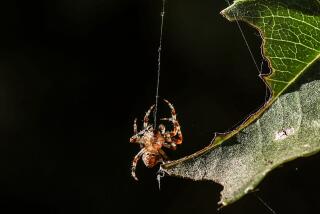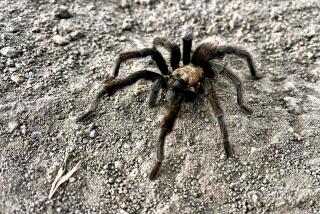How do these jumping spiders see color? The secret is in their eyes
- Share via
If a spider’s eight eyes don’t impress you, consider this: Some of them can even see in “true” color. Scientists have studied the vision in a group of brightly-hued jumping spiders and have finally discovered how their remarkable visual system works.
The findings, published in the journal Current Biology, shed new light on the evolution of color vision in these arachnids, which use a filtering technique that had never been described in any spider species before.
The Salticidae family of jumping spiders are generally tiny – often less than a centimeter across – and fierce little predators, stalking and pouncing on their prey. They have four modular sets of eyes positioned around their heads that give them a 360-degree view. But the group had been known to have only two types of light-sensitive pigment, one sensitive to ultraviolet wavelengths and the other to green wavelengths, which limits their color sensitivity. (Some other animals, humans included, have a system that’s sensitive to three different regions of in the light spectrum – usually green, blue and red – which is what allows them to see a wide range of colors.)
A subset of these agile arachnids, however, actually does seem to be able to pick shades out of a wider palette. This group includes the genus Maratus, or ‘peacock’ spiders, which mostly reside in Australia, as well as the genus Habronattus, found mostly in North and Central America. The males of these species often have boldly painted bodies that they use to attract the attention of a female spider (which are much duller in color).
Clearly, color must be important to these spiders – otherwise, it would mean that they’d have gotten all dressed up for nothing. And if the spiders can see color, the poor color-sensing in the green-UV system of most other jumping species would not be enough to explain this ability.
“Such poor spectral discrimination seems mismatched to the diverse color palette of H. pyrrithrix and its congeners,” the authors wrote in a study led by Daniel Zurek of the University of Pittsburgh. There had to be something else going on in the eyes of these colorful spiders.
To find out how these critters could see color, the scientists looked at sections of the jumping spider Habronattus pyrrithrix using spectrophotometry, which measures a substance’s light absorption. They found that while the spiders did indeed have the typical two types of light-sensitive pigment – one for ultraviolet light, and one for green light – a subset of the green pigments had a filter over them that shifted the photoreceptors’ sensitivity from green to red, rather like a pair of tinted sunglasses.
“Trichromatic vision resulting from this filter system should markedly enrich these animals’ perception of color, including reds, oranges and yellows often found in their courtship displays,” the study authors wrote. (The males typically sport bright red faces.)
This upgraded color system only exists in a small part of the spider’s retina, however – giving it a very narrow field of color vision. That could present a few challenges for even the most discerning female jumping spider, the scientists said – though it could explain their strange gaze movements, which a 1969 paper in the Journal of Experimental Biology described as “elaborate and unique ‘scanning’ process, in which both retinae move back and forth across the target, while at the same time partially rotating about the visual axes of the eyes.”
The scientists found that these color filters that turned two-pigment systems into essentially three-pigment systems were common across several species of Habronattus spiders – and could explain why this particular genus of spider has become so successful and diverse.
Though this is a question for future study, it’s possible that being able to see such a wide range of colors could have allowed the spiders to notice prey with the kind of red and yellow coloring meant to warn predators off from a toxic meal.
“Our study offers a solution to the long-standing puzzle of how some salticids see color and opens the door for future studies on co-evolution of color vision and coloration,” the study authors wrote.
Follow @aminawrite on Twitter for more creepy crawly science news.







